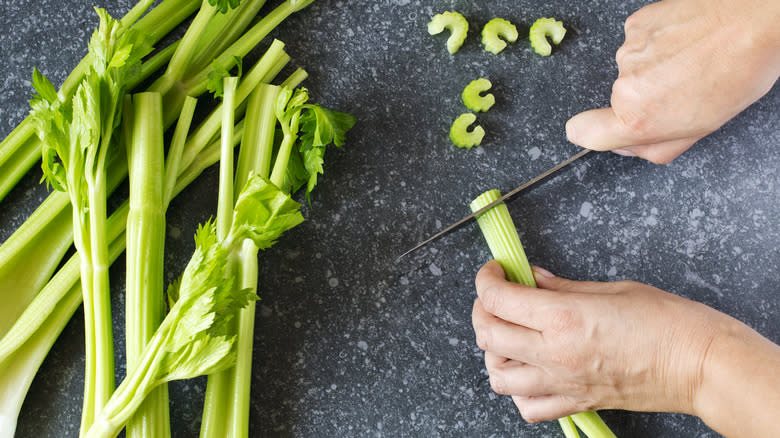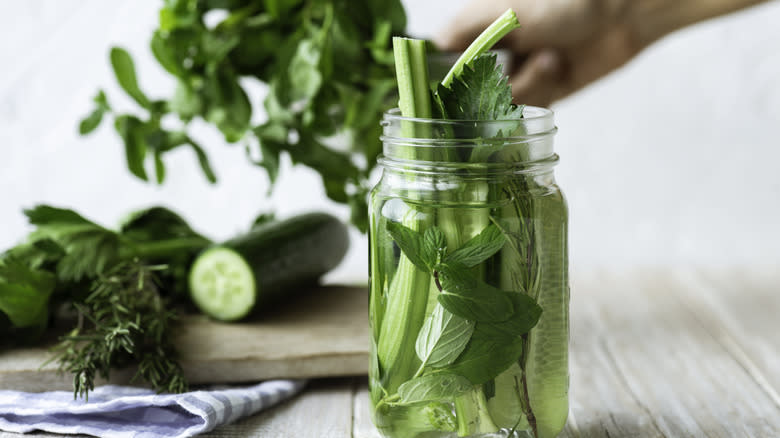How To Properly Clean Fresh Celery

Celery is a mainstay in many kitchens worldwide, generally used as part of a flavor base for other ingredients like in a mirepoix, though also enjoyed on its own as part of a crudité platter or stirrer for a bloody mary. It is relatively easy to prepare for cooking, but with its tightly packed stalks, sometimes tiny bits of dirt get overlooked when cleaning. How then do you properly clean fresh celery?Before anything else, you have to separate the celery stalks from each other first instead of washing them immediately upon removing them from the bag. This exposes the spaces between the stalks, plus makes it much easier to portion for cooking throughout the week.On to washing: There are two ways you can do this part, which is either to rinse the celery stalks under the faucet or to soak them in a basin of cold water. The method you choose depends on your kitchen prep workflow preferences. If you are wary of bugs on the stalks, add a little salt or vinegar to the soaking water and that should dispatch said bugs rather quickly.Finally, dry the celery stalks with paper towels. You never knew that celery, of all things, could be described as "spick and span", but that is the result!
Read more: You've Been Cutting These Vegetables The Wrong Way
How To Store Celery

Unless celery is the main star of the dish, it is not likely that you will finish a whole bunch of celery in one go. Thus, you will need to properly store all this precious clean celery to make it last as long as possible.
An orderly way to do this is to first separate the different parts of the celery from one another. Trim the leaves from the stalks, then further trim the thinner end of the stalks from the thicker parts. These three components can be stored separately so that they can be used for different purposes (more on this later!) The thinner parts of the stalks wilt faster than the thicker parts, and storing them separately makes it easier to plan which bits need to be cooked first.
A top tip for keeping celery crisp is by tightly wrapping it in aluminum foil. And if your celery goes limp for whatever reason, simply bring it back to life by sticking the stalks in a glass of cold water overnight.
If you still have celery left over but will not be cooking it anytime soon, consider storing it in the freezer. Briefly blanch the stalks in boiling water then rapidly cool them down in iced water. Place them in a zip-top baggie before putting them in the freezer for future soups and stocks.
How To Use Celery

Now that you have these beautifully cleaned and trimmed celery stalks and leaves, how do you use them? The thinner stalks can be cooked whole in Chinese-style stir-fries, whether with other vegetables or added proteins like pork and beef. The thick ends are best finely chopped to be used as aromatics, and are famously part of the "holy trinity" of vegetables used in Cajun and Creole dishes, along with green bell pepper and onions.
Celery stalks are also often used raw, like in the aforementioned crudité platters and bloody marys. Try them too in that nostalgic snack of ants on a log, or chop them up to add to protein-packed salads like egg or tuna salads (though it is recommended to peel them first to make them easier to chew).
Finally, do not overlook celery leaves! These are often added as a garnish to soups and are even known as "daun sup" in East Asian countries, which roughly translates to "soup leaves." Now that you know how to properly clean these greens, the options for using them are endless.
Read the original article on Daily Meal.

